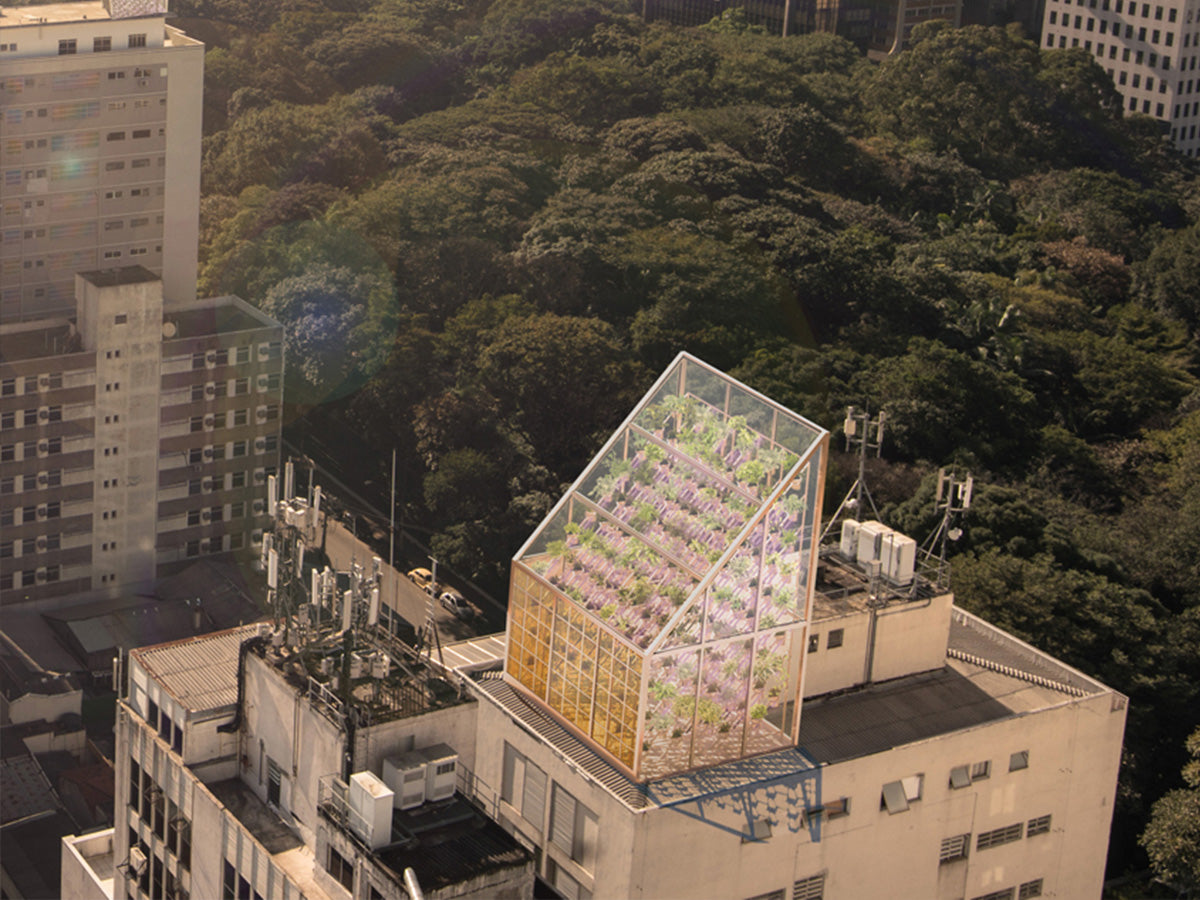Marjan van Aubel

When we think of solar technology, we think of the reflective panels on roofs. We know they turn sunlight into electricity, and we merely expect them to simply function. But, when you think about it, sunlight is free and available to everyone. We get it in abundance. In fact, WE RECEIVE ENOUGH SUNLIGHT EVERY HOUR TO PROVIDE THE WORLD’S ELECTRICITY FOR AN ENTIRE YEAR.
So, why aren’t we constantly harvesting this source of energy at its full potential? Why don’t we see more solar technology around us? Why isn’t every surface covered with solar panels, and why aren’t our machines running on solar energy? If you look around, there are many potential surfaces that could be harvesting energy, yet there is no room for more imagination here. What and who is stopping us? And why?
Let’s go back in time and consider how we got here. Our story starts back in 1839, with the discovery of the photovoltaic effect. This principle, where an electric current is formed when an electrode is being activated through light, still forms the basis of solar technology. The first photovoltaic cells (PV) were developed in 1883, using selenium on a thin layer of gold. These expensive cells had an efficiency of less than 1%, which is not much compared to current solar cells (which are about 20-30% efficient, meaning of all the light they receive, 30% is being converted into usable energy).
Since then, several patents have been granted and after a lot of development, the first commercially viable solar panels were produced and installed in the 1950s. In 1958, the first satellite with solar panels went into space; the Vanguard 1. It used the power generated by its PVs to send signals back to the earth. The idea of integrating solar panels into smaller products was also born in this decennium. Researchers at New York University predicted that household applications like toasters, heaters and mixers using solar panels as their power sources might be in worldwide use in the 1960s and onwards, but that didn’t happen. Electricity was cheap and the price of silicon, a basic element in solar cells, was high, while the efficiency of cells was low, only reaching around 12% efficiency.
The focus of embedding solar technology shifted from small household objects to space applications such as satellites. Here, having solar panels on board made much more sense as it meant that some functions of the satellite could function independently using the power of the sun. Much higher risks and costs were involved here, compared to the everyday household objects. Since the development of solar technology, now nearly 70 years ago, the focus of its production has been mainly on price reduction and increasing the efficiency of the technology. Scale has been an important factor. Something that is new, is expensive, and only by producing on a mass scale, prices will lower.
Now that solar panels are being produced on a very large scale in China, this price has decreased immensely — the cost of electricity from solar sources has dropped by 75 percent since 2009. Expectations are that this trend will continue. The panels’ efficiency has increased; now solar cells have an efficiency of 34%, and in the coming years, its performance is expected to double. Some people say we have even been too pessimistic about the adaptation of solar technology. Speculations are that by 2050 solar and wind energy will generate half of the world’s electricity.
To reach the goals of the Paris Climate Change Agreement made in 2016, more than half of our energy sources must be renewably sourced by 2030. The only country even close to reaching this goal is Germany. Most countries are far behind this target and the current status is that the crucial threshold of an increase of 1.5 degrees celsius will be reached by 2030; leading to heatwaves, floods, rising sea levels and food shortages. Solar energy will play an important role in minimising CO2 emissions. But development is slow, and we’re still taking fossil fuels from the ground when we should be looking up to the sky.
WHAT IS STOPPING US NOW FROM FULL INTEGRATION?
Here are some factors that help answer this question:
— i — Coal and gas generators are still being built and are still producing electricity. As long as they keep on making a profit they will keep on existing.
— ii — Sunlight is unreliable and unpredictable. Sometimes there’s no sun for days, and existing grids can’t handle this unpredictability.
— iii — Storage (in the form of batteries) is expensive, as batteries are made of rare materials.
This price reduction and focus on making solar panels more efficient is needed for large adaptation of PV. But it is still not enough to ensure adoption by consumers, homeowners and cityscapes. Rules and regulations can prevent access to these technologies.
For someone who doesn’t own their own house, or lives in an old city such as Amsterdam, it is often not permitted to have solar technology on their roof as it will influence the protected architecture. How can these regulations be adapted or influenced? There are schemes such as renting solar panels on a different location outside the city to have access to solar panels. However, consumers will then lack awareness of where their energy comes from. The relation between energy production and its surroundings needs to be reconsidered. True behavioural change is needed for the adoption of a cleaner technology. To do this, design plays a significant role.
Not only price and efficiency are needed to bring forth change. The image of solar technology itself needs to change. People need to be aware that panels no longer have to be black or blue and that they always have to be directed at a certain angle towards the sun. With design, we can make solar panels fit into our environment, and make people start seeing solar panels as part of our natural environment. Good design even becomes invisible — when solar panels are fully embedded in our lives they’ll become a ‘natural’ part of us. Only when something is extreme or outstanding we start to notice it again. New technologies make it possible to have more choice in placing and integrating solar panels naturally; in terms of orientation and positioning, colour, transparency and even flexibility. These developments are needed for adaptation of the technology. Even more so in cities where the energy is needed most and space is a scarcity.
TWO THINGS NEED TO (AND WILL) HAPPEN TO SOLAR TECHNOLOGY: SOLAR PANELS SHOULD BECOME ‘INVISIBLE’ AND THEY SHOULD BECOME AN AESTHETIC FEATURE.
For the first point: Solar panels can be integrated into glass windows, facades and roof tiles, and will therefore become completely ‘invisible’. A good example of this are Elon Musk’s Roof shingles. They’re made in such a way that you don’t notice them from the street due to a clever reflector system. Other techniques make it possible to print a layer of solar panels so they can blend in completely into their environment.
As for becoming a feature: Consider the windmill. Windmills now form an iconic presence in the Dutch landscape. That is: the historical windmills. People still oppose the placement of modern windmills (along with solar parks), as the common perception is this technology ruins both the landscape and the view. Imagine if people in the past were against the placement of windmills, and knew now they’re now considered as monuments we are proud of. Perhaps we can we design solar panels in a similar way, so that we too will become product of them and start to see them as monuments.
Sunlight is still free and available for everyone. What we don’t want is to centralise all that power so that only the big solar farms and energy companies control this resource. We now have the opportunity to integrate solar technology into our everyday environment and to democratise it, see every surface as an opportunity, and to make solar energy accessible to everyone and not only for the people that can afford a sustainable lifestyle.
Solar panels can become smaller, portable and invisible. But we also have a choice of how this future solar world will look like. Can solar energy be a solution outside the energy industry, and solve problems such as food shortage? What kind of new possibilities would open up if energy becomes free? What if every surface or object would turn into power sources and power themselves, and how will they be distributed? Windows, street, houses, cities that get these extra functions and also work as power sources that generate electricity. How will this world function, and what would it look like if solar becomes our dominant supplier of energy?
ABOUT THE AUTHOR
Marjan van Aubel is an award-winning solar designer whose innovative practice spans the fields on sustainability, design and technology. Through her practice, she strives to redefine our current relationship with solar technology and accelerate its transition to ubiquity. Her work is part of collections at the MoMa, the Vitra Design Museum, Boijmans van Beuningen Museum and The Montréal Museum of Art amongst others.
@marjanvanaubel
Amsterdam, Netherlands



